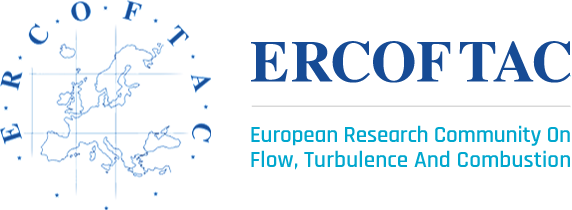ERCOFTAC PC Iberia
Simulation of an Active Flow Control System in an Airplane Wing
Authors: Guillermo Marin, Jeronimo Calderon, Miguel Esteban, Ivette Rodriguez, Ricard Montalà, Oriol Lehmkuhl
(Barcelona Supercomputing Center, Spain)
This visualization video displays the effect of wing jets in stabilizing the air vorticity around an airplane in a transitory simulation at angle of attack 14.The q-vorticity is mapped to the density of the volume, and the velocity magnitude to color. We used a proprietary pipeline to convert simulation outputs into a modified OpenVDB [1] volume format that preserves the size differences between computational mesh elements. The simulation output, with ~56 million integration points, was converted to a multi-resolution volume of ~8 million voxels. OpenVDB is widely supported by most visual effects software, thus, our pipeline bridges simulation data with high-end cinematic production tools. This video has been produced in SideFX Houdini and edited in Adobe AfterEffects.
[1]. Museth, K., et al. (2013). OpenVDB: an open-source data structure and toolkit for high-resolution volumes. In Acm siggraph 2013 courses (pp. 1-1).
Abstract
Synthetic (zero net mass flux) jets are an active flow control technique to manipulate the flow field in wall-bounded and free-shear flows. The present work focuses on the role of the periodic actuation mechanisms on the boundary layer of a SD7003 airfoil at 𝑅𝑒=𝑈∞𝐶/𝜈=60000 [4]. Here, Reynolds number is defined in terms of the free-stream velocity 𝑈∞ and the airfoil chord C. The actuation is applied near the leading edge of the airfoil and is periodic in time and in the spanwise direction. The actuation successfully eliminates the laminar bubble at 𝐴𝑜𝐴=4∘, however, it does not produce an increase in the airfoil aerodynamic efficiency. At angles of attack larger than the point of maximum lift, the actuation eliminates the massive flow separation, the flow being attached to the airfoil surface in a significant part of the airfoil chord. As a consequence, airfoil aerodynamic efficiency increases by 124% with a reduction of the drag coefficient of about 46%. This kind of technique seems to be promising at delaying flow separation and its associated losses when the angle of attack increases beyond the maximum lift for the baseline case. To carry out the calculations the open source CFD code, SOD2D[3] is used together with MareNostrum 5 (https://gitlab.com/bsc_sod2d/sod2d_gitlab). MN 5 is a pre-exascale EuroHPC supercomputer hosted at BSC-CNS. The system is supplied by Bull SAS combining Bull Sequana XH3000 and Lenovo ThinkSystem architecture and it has a total peak computational power of 314PFlops. SOD2D has been developed with the aim of efficiently leveraging the computational power that is being deployed worldwide in which GPU plays a central role. For that reason, it has been developed to be able to run on either GPU or CPU architecture. Specifically, the code is written in Fortran and uses MPI and Open ACC to provide parallelism at both coarse and fine-grained levels.
The mesh is partitioned using the GEMPA library, and it uses HDF5forI/O which are efficient and widely tested libraries for HPC. The scalability of SOD2D has been tested up to 2000 GPUs solving problems of about 6 Billion nodes. The filtered incompressible Navier-Stokes equations are numerically solved using a low-dissipation spectral element method (SEM) methodology. For the temporal discretization, a BDF-EXT3 high-order operator splitting approach is used to solve the velocity-pressure coupling, allowing for equal order interpolation of velocity and pressure. Projection stabilization precludes numerical oscillations due to dominant convection while introducing very low numerical dissipation. The aliasing effects of the reduced order integration caused by employing SEM integration for convective terms are countered with a skew-symmetric splitting. Future work is focused on the use of deep reinforcement learning (DRL) for active flow control (AFC) [2]. Combining DRL and AFC can yield promising results in the field of flow control, discovering more sophisticated actuation strategies that can produce more complex flow interactions and hence push the limits of AFC.
References
[2] Font, B., Alcántara-Ávila, F., Rabault, J., R. Vinuesa and O. Lehmkuhl. Deep reinforcement learning for active flow control in a turbulent separation bubble. Nat Commun 16, 1422 (2025).
[3] L. Gasparino, F. Spiga, O. Lehmkuhl, SOD2D: A GPU-enabled Spectral Finite Elements Method for compressible scale-resolving simulations, Computer Physics Communications, Volume 297, 2024.
[4] Rodriguez, I., Lehmkuhl, O. and Borrell, R. Effects of the Actuation on the Boundary Layer of an Airfoil at Reynolds Number Re = 60000. Flow Turbulence Combust 105, 607–626 (2020).
